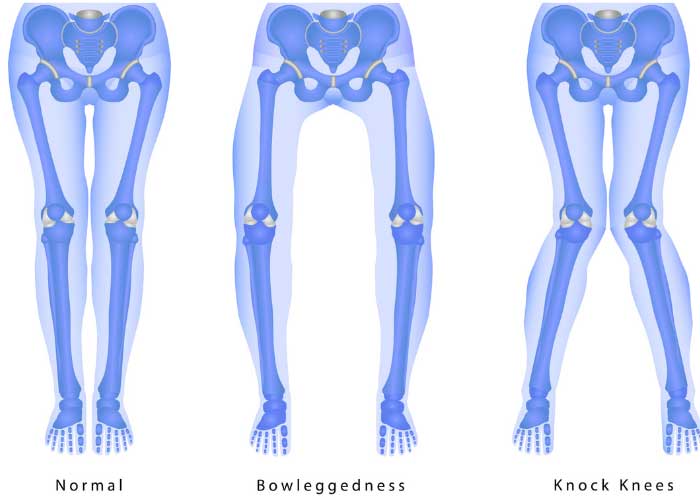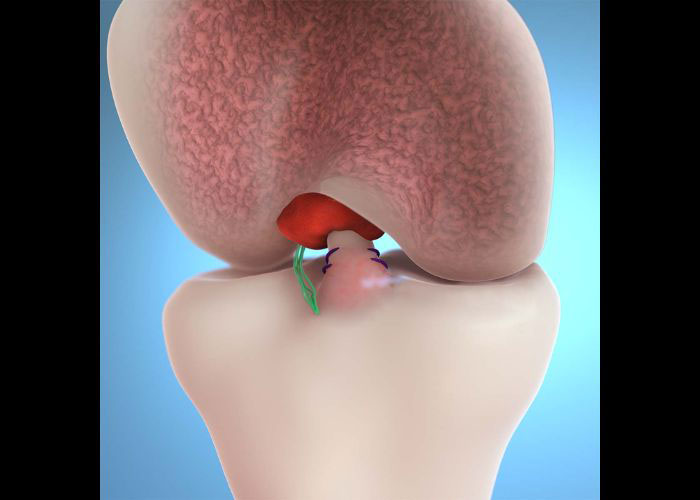What is knee malalignment?
The femur (thigh bone), tibia (shin bone), and patella (kneecap) join together with an intricate arrangement of soft-tissue structures to form the knee joint. For this joint system to function properly, it is heavily reliant on a correct bone alignment to evenly distribute the weight throughout the joint. When any of these bones shift away from a straight line then the body’s weight is no longer evenly distributed and can result in a dislocation or osteoarthritis. A traumatic event, birth-related complications, or the natural aging process can lead to knee malalignment.

What is varus malalignment or bow-legged?
When the knees are bowing outward this results in a “bow-legged” appearance known as varus malalignment. The femur is no longer in line with the tibia in this condition which causes the knee to shift outward. The considerable increase in the amount of weight exerted on the inner portion of the knee can precipitate early-onset osteoarthritis.
What is valgus malalignment or knock-kneed?
Valgus alignment or “knock-kneed” occurs from the malalignment between the hip, knee, and ankle. The result is a bowing inward of the knees causing the outer portion of the knee to bear more weight. Similar to varus alignment, this condition affects the articular cartilage and can cause premature onset of osteoarthritis. Dr. Ronak Mukesh Patel, orthopedic knee specialist serving patients in Sugar Land, Pearland, and the Houston, Texas area, has the knowledge and understanding, as well as substantial experience in treating patients who have experienced knee malalignment.
What are the symptoms of knee malalignment?
Knee pain that worsens with angulation of the knee joint is commonly reported with knee malalignment. Some other common symptoms of knee malalignment include:
- Knee swelling and stiffness
- Pain underneath the patella
- A “locking” or “catching” sensation
- Knee instability or the feeling of the knee “giving out”
- A “clicking” sound with knee extension
How is knee malalignment diagnosed?
A comprehensive medical history will be obtained by Dr. Patel. Following this interview, a thorough physical examination will be conducted to measure the degree of knee malalignment. Diagnostic imaging studies, such as x-rays, computed tomography (CT) scan, magnetic resonance imaging (MRI), can be beneficial in confirming the degree of knee malalignment.
What is the treatment for knee malalignment?
Non-surgical treatment:
Patients with minimal knee malalignment may benefit from conservative therapies alone. Activities that wear and tear on the knee should be avoided. Pain and inflammation can be reduced with a combination of rest and non-steroidal anti-inflammatory medications (NSAIDs). Eventually, strength training in a physical therapy program can reduce any unnecessary pressure off the knee. Bracing can also be utilized to unload the knee.
Surgical treatment:
Patients with persistent pain after initial conservative therapy typically require surgical intervention to mechanically correct their knee alignment. Dr. Patel will assess the patient’s age, medical history, activity level, and desired recovery goals to determine an appropriate surgical technique. An osteotomy, a procedure that cuts a wedge from the end of a bone, is the standard practice for correcting knee malalignment. The following are some of the osteotomy surgical techniques that can be performed to correct knee malalignment:
- Distal Femoral Osteotomy: A wedge at the end of the femur bone closest to the knee joint (distal) is cut and removed. A metal plate is fastened and bone graft material can be inserted into the new opening. This procedure is used to correct valgus alignment.
- High Tibial Osteotomy: A wedge of the tibial bone closest to the knee joint (proximal) is cut and removed, and the remaining bone ends are aligned with plates and screws. Patients with varus alignment are good candidates for this procedure.
Knee Malalignment Specialist

There are two types of knee malalignment, Varus (bowlegged) and Valgus (knock-knee). Both types of knee malalignment can cause uneven wear and tear to the meniscus and/or articular cartilage in the knee, as well as cause knee and hip pain. Doctor Ronak Mukesh Patel, provides diagnosis as well as surgical and nonsurgical treatment options for patients in Houston, Sugar Land, and Pearland, TX who have these types of malalignment of the knee. Contact Dr. Patel’s team today!








